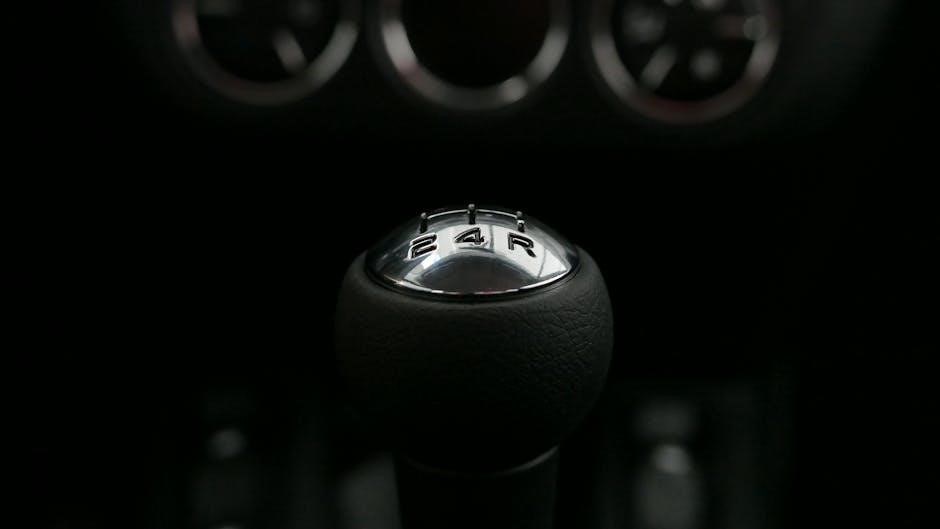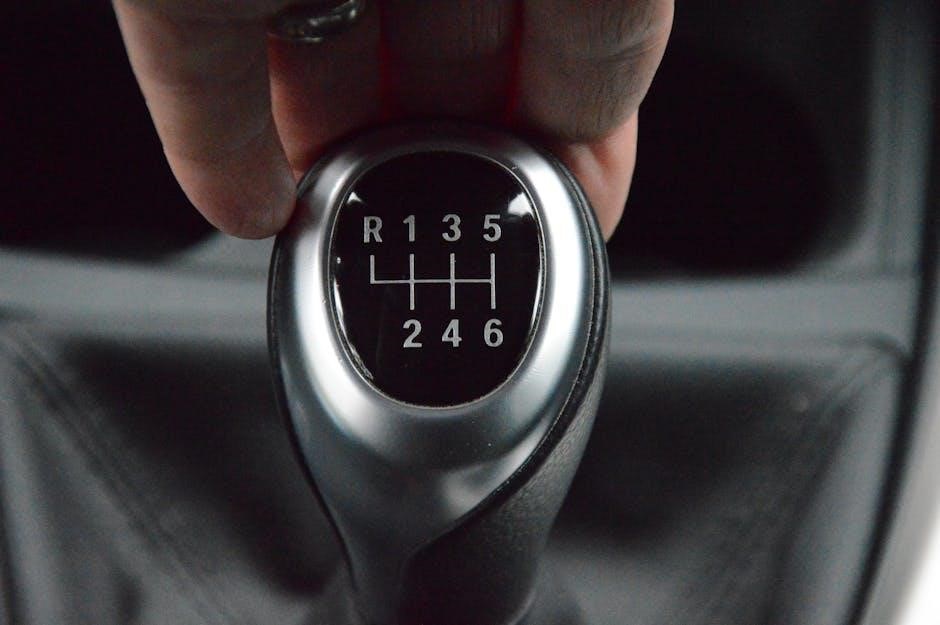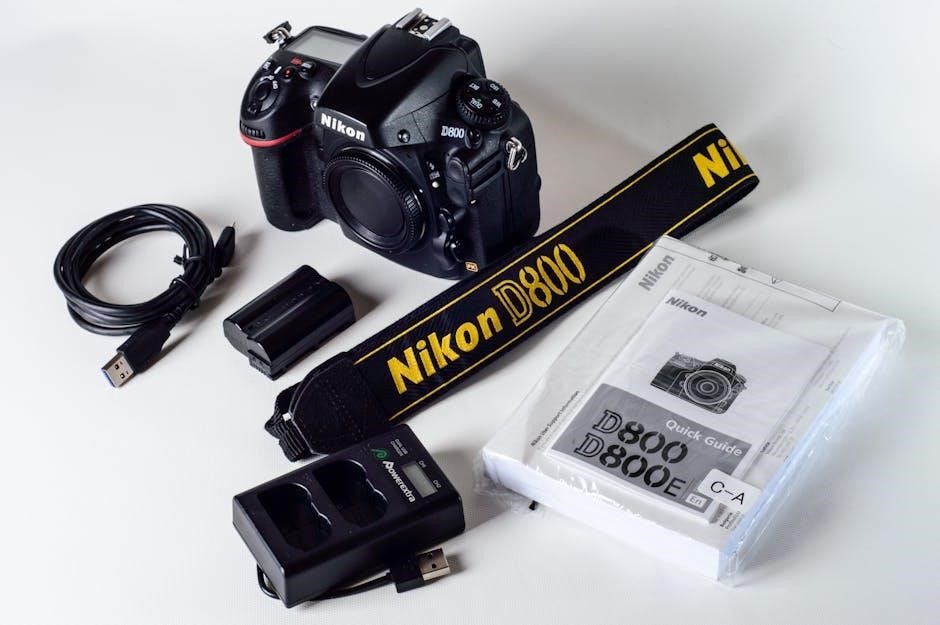Welcome to the Greenworks 2000 PSI Pressure Washer manual! This guide covers the GPW2000 model, offering essential safety tips, assembly steps, and usage instructions for optimal performance.
1.1 Overview of the Greenworks 2000 PSI Pressure Washer
The Greenworks 2000 PSI Pressure Washer is a powerful, eco-friendly cleaning solution designed for various tasks. With a 2000 PSI rating and 1.2 GPM flow rate, it efficiently tackles dirt and grime. Suitable for cleaning vehicles, decks, and siding, it features a durable 14-amp motor and three interchangeable nozzle tips for versatility. The unit is mostly pre-assembled, requiring minimal setup. Its compact design and lightweight construction make it easy to maneuver. Ideal for homeowners seeking a reliable and environmentally conscious pressure washer, this model balances performance and affordability, supported by a 3-year warranty and dedicated customer service.
1.2 Importance of the Manual
This manual is crucial for safe and effective use of the Greenworks 2000 PSI Pressure Washer. It provides essential safety precautions, assembly instructions, and maintenance tips to ensure optimal performance. By following the guidelines, users can avoid accidents and extend the product’s lifespan. The manual also includes troubleshooting solutions for common issues, helping you resolve problems quickly. Understanding the warranty terms and conditions is vital for knowing what is covered and how to seek support. Reading and adhering to the manual ensures you make the most of your pressure washer while maintaining safety and efficiency in your cleaning tasks.
1.3 Model Number and Variants (GPW2000, PWA201, etc.)
The Greenworks 2000 PSI Pressure Washer is available under model numbers GPW2000 and PWA201. These variants share similar specifications, delivering 2000 PSI and 1.2 GPM for efficient cleaning. The GPW2000-1RBSC is another popular variant, offering the same power with a focus on eco-friendly design. All models include three nozzle tips for versatility. Whether you’re cleaning vehicles, decks, or driveways, these models provide consistent performance. Ensure to refer to the correct manual for your specific model to understand unique features and maintenance requirements. This guide covers all variants, ensuring comprehensive support for optimal use and care of your pressure washer.

Safety Precautions
Ensure safe operation by following all safety warnings, maintaining proper footing, and avoiding unstable surfaces. Adhere to ground fault protection guidelines to prevent accidents.
2.1 General Safety Warnings
To ensure safe operation, always follow these guidelines: Never overreach or stand on unstable surfaces while using the pressure washer. Maintain proper footing and balance at all times to prevent accidents. Avoid using the machine in wet conditions or exposing it to extreme temperatures. Keep children and pets away from the area during operation. Always turn off the power and allow the machine to cool before performing maintenance. Follow all instructions provided in this manual carefully, and use only recommended accessories to avoid damage or injury.
2.2 Ground Fault Protection Instructions
Ensure the pressure washer is connected to a properly grounded electrical outlet to prevent ground faults. Use a Ground Fault Circuit Interrupter (GFCI) outlet for added safety, especially in damp environments. Never operate the machine with a damaged cord or plug, as this can lead to electrical hazards. Avoid touching electrical components with wet hands or while standing in water. If a ground fault occurs, disconnect the power immediately and contact a qualified electrician. Always prioritize electrical safety to prevent shocks or injuries during operation.
2.3 Proper Footing and Balance Guidelines
Maintain stable footing and balance while operating the Greenworks 2000 PSI Pressure Washer to ensure safe use. Stand on a firm, level surface and avoid unstable or slippery ground. Never overreach or stretch excessively, as this can cause loss of balance. Keep the work area clear of clutter and ensure good traction. Wear non-slip footwear and avoid operating the machine in wet conditions without proper footing. If the surface is uneven or unstable, relocate to a safer area before continuing. Proper balance reduces the risk of accidents and ensures effective control of the pressure washer during operation.

Product Specifications
The Greenworks 2000 PSI Pressure Washer delivers 1.2 GPM flow rate, powered by a 14-amp motor. It includes three nozzle tips for versatile cleaning tasks efficiently.
3.1 Pressure (PSI) and Flow Rate (GPM)
The Greenworks 2000 PSI Pressure Washer operates at a maximum pressure of 2000 pounds per square inch (PSI) and a flow rate of 1.2 gallons per minute (GPM). This combination ensures efficient cleaning power for various tasks, from light-duty cleaning to more challenging jobs. The pressure and flow rate are optimized for residential use, providing a balance between cleaning effectiveness and water conservation. Always ensure the pressure and flow settings are appropriate for the surface being cleaned to avoid damage and achieve the best results.
3.2 Motor Power and Voltage Requirements
The Greenworks 2000 PSI Pressure Washer is equipped with a powerful 14-amp motor, designed to deliver consistent performance. It requires a 120-volt electrical supply, ensuring compatibility with standard household outlets. For safe operation, use a Ground Fault Circuit Interrupter (GFCI)-protected circuit and avoid extension cords to maintain optimal power delivery. Do not exceed the recommended voltage or power ratings, as this could damage the motor. Always ensure the electrical connections are secure and follow the manual’s guidelines for proper setup and usage to maximize efficiency and safety.
3.3 Included Nozzles and Accessories
The Greenworks 2000 PSI Pressure Washer comes with three interchangeable nozzle tips (25°, 40°, and soap) to suit various cleaning tasks; A 25-foot high-pressure hose is included for extended reach, along with a spray gun and wand assembly. The package also features a detergent bottle for applying soap or cleaning solutions. Additional accessories may include a storage hook for the gun and nozzles. Ensure all components are properly connected and compatible with the unit for optimal performance. Refer to the manual for specific instructions on using and maintaining these accessories to ensure longevity and efficiency.

Assembly Instructions
This section guides you through assembling the Greenworks 2000 PSI Pressure Washer, including unpacking, attaching components, and connecting essential parts for proper setup.
4.1 Unpacking and Initial Setup
Begin by carefully unpacking the Greenworks 2000 PSI Pressure Washer from its box. Inspect the unit for any damage during shipping. Remove all items, including the pressure washer, hose, nozzles, and accessories. Check that all components are included as listed in the manual. Ensure the machine is placed on a stable, flat surface. Before proceeding, read the entire manual to understand safety precautions and assembly steps. Familiarize yourself with the controls and connections. Store the original packaging in case you need to transport the unit later. Properly dispose of packing materials according to local regulations.

4.2 Attaching the Handle and Other Components
To assemble the Greenworks 2000 PSI Pressure Washer, start by attaching the handle. Align the handle with the designated mounting points on the unit and secure it using the provided bolts. Tighten firmly to ensure stability. Next, attach the spray gun and wand to the hose. Make sure all connections are tight to prevent leaks. Finally, check that all components are properly aligned and the machine is balanced. Refer to the manual for specific torque requirements and ensure no components are loose before use. Keep the area clear of debris for safe assembly.
4.3 Connecting the Hose and Electrical Cord
To connect the hose and electrical cord, first attach the garden hose to the water inlet on the pressure washer. Ensure the connection is tight to prevent leaks. Next, attach the high-pressure hose to the spray gun and wand, securing it firmly. Plug the electrical cord into a grounded outlet, ensuring it is free from damage or kinks. Avoid overstretching the cord or exposing it to water. After use, roll up the hose and cord neatly, storing them in a dry place to prevent damage. Always follow the manual’s instructions for proper setup and safety guidelines.

Operating Instructions
Start the machine, adjust pressure, and use appropriate nozzles for different surfaces. Regular maintenance ensures optimal performance and longevity of your Greenworks pressure washer.
5.1 Starting the Machine
To start the Greenworks 2000 PSI Pressure Washer, ensure the machine is on a stable surface. Turn on the water supply and pull the gun trigger to release air pressure. Once a steady water flow is achieved, the machine is ready for operation. Always wear eye protection and keep the area clear of obstacles. Follow the manual’s guidelines for proper startup to ensure safety and efficiency. This step is crucial for optimal performance and longevity of the pressure washer.
5.2 Adjusting Pressure and Flow
The Greenworks 2000 PSI Pressure Washer allows you to adjust pressure and flow for optimal cleaning. Turn the water supply on and off to regulate pressure. Use the included nozzle tips to modify flow rate and spray pattern. For lighter tasks, switch to a wider-angle nozzle, while narrower nozzles increase pressure for tough stains. Always test the setting on a low-pressure surface first. Adjustments should be made with the machine turned off to ensure safety and avoid sudden pressure changes. Proper adjustment enhances efficiency and prevents damage to surfaces being cleaned. Follow the manual for specific guidance on nozzle selection and pressure control.
5.3 Using Different Nozzle Tips
The Greenworks 2000 PSI Pressure Washer comes with interchangeable nozzle tips to suit various cleaning tasks. The 40° nozzle is ideal for delicate surfaces, while the 25° nozzle is better for general cleaning. The 15° nozzle is designed for tough stains, and the 0° nozzle provides a concentrated jet for heavy-duty cleaning. Always choose the appropriate nozzle for your task to avoid damage. To change nozzles, pull and twist until they click securely into place. Test the spray on a low-pressure surface first to ensure proper adjustment. Refer to the manual for specific nozzle recommendations and usage guidelines.

Maintenance Tips
Regularly clean the pressure washer and lubricate moving parts. Winterize by draining water and using a pump saver. Store in a dry, protected area to prevent damage.
6.1 Regular Cleaning and Lubrication
Regular cleaning and lubrication are crucial for maintaining your Greenworks 2000 PSI Pressure Washer. Start by turning off and unplugging the machine. Remove any dirt or debris from the outer surfaces using a soft cloth. Inspect and clean the nozzle tips to ensure proper water flow. Lubricate moving parts, such as the wheels and hinges, with a silicone-based spray to prevent rust and wear. Always refer to the manual for specific lubrication points. Regular maintenance ensures optimal performance and extends the lifespan of your pressure washer.
6.2 Winterizing the Pressure Washer
To winterize your Greenworks 2000 PSI Pressure Washer, start by draining all water from the hose and pump. Use a pump saver product as instructed to protect internal components from freezing. Disconnect and drain the hose, then store it in a dry place. Store the machine in a sheltered, upright position to prevent water from pooling. Avoid leaving the pressure washer exposed to extreme cold. Follow these steps to ensure your washer remains in good condition during the off-season and is ready for use when needed again.
6.3 Storing the Machine Properly
Store your Greenworks 2000 PSI Pressure Washer in a dry, well-ventilated area protected from extreme temperatures and moisture. After winterizing, ensure the machine is clean and free of debris. Roll up the hose neatly, avoiding kinks, and secure it to the unit. Store the pressure washer upright to prevent water from pooling. Use a protective cover to shield it from dust and dirt. Keep it out of reach of children and pets. Proper storage will extend the lifespan of your pressure washer and ensure it performs optimally when you need it again.

Troubleshooting Common Issues
7.1 Low Pressure or No Water Flow
Check for clogged nozzles, kinked hoses, or blocked water inlets. Ensure the correct nozzle tip is used and the water supply is adequate. Inspect the pump for debris or damage. If issues persist, refer to the troubleshooting guide or contact Greenworks support for assistance. Always follow safety precautions when diagnosing and repairing your pressure washer.
Check for clogged nozzles, kinked hoses, or blocked water inlets. Ensure the correct nozzle tip is used and the water supply is adequate. Inspect the pump for debris or damage. If issues persist, refer to the troubleshooting guide or contact Greenworks support for assistance. Always follow safety precautions when diagnosing and repairing your pressure washer.
7.2 Leaks in the Hose or Connections
Inspect the hose and connections for visible damage or wear. Tighten any loose fittings or couplers. If leaks persist, replace worn O-rings or gaskets. Ensure all connections are secure before operation. Turn off the machine and allow it to cool before inspecting for leaks. If the issue remains unresolved, refer to the troubleshooting guide or contact Greenworks customer service for further assistance. Regular maintenance can help prevent leaks and ensure optimal performance of your pressure washer.
7.3 Motor Not Starting
If the motor fails to start, first ensure the power cord is securely plugged into a functioning outlet. Check the circuit breaker or GFCI to confirm power supply. Verify that the water supply is turned on and properly connected. If using a pump saver, ensure it is installed correctly. Allow the machine to cool down if it has been in use. If the issue persists, consult the troubleshooting guide or contact Greenworks customer service for assistance. Regular maintenance and adherence to the manual’s instructions can help prevent such issues and ensure smooth operation.

Warranty Information
Greenworks offers a comprehensive warranty covering repairs or replacements for defective parts. Contact their toll-free helpline at 1-888-90WORKS for assistance and detailed warranty terms.
8.1 Warranty Coverage and Duration
The Greenworks 2000 PSI Pressure Washer is backed by a 3-year limited warranty, covering manufacturing defects in materials and workmanship. This warranty applies to the original purchaser and commences from the purchase date. It ensures that defective parts will be repaired or replaced at no additional cost, provided the product has been used and maintained as per the instructions in this manual. For details on specific coverage and exclusions, refer to the warranty section or contact Greenworks Customer Service at 1-888-90WORKS (888.909.6757).
8.2 Exclusions and Conditions
The warranty excludes damage caused by misuse, neglect, or unauthorized repairs. Normal wear and tear, improper maintenance, or failure to follow manual instructions are not covered. Issues arising from natural disasters, accidents, or alterations to the product are also excluded. The warranty does not cover accessories or parts damaged due to improper use. For full details, refer to the warranty section in the manual or contact Greenworks Customer Service at 1-888-90WORKS (888.909.6757) for clarification on specific exclusions and conditions.
8.3 Contacting Greenworks Customer Service
For assistance with your Greenworks 2000 PSI Pressure Washer, contact customer service at 1-888-90WORKS (888.909.6757). Representatives are available to help with troubleshooting, warranty claims, or general inquiries. You can also visit the official Greenworks website for support resources, including FAQs and contact forms. Ensure to have your model number (e.g., GPW2000) and purchase details ready for efficient service. Greenworks is committed to providing timely and effective support to ensure your pressure washer operates at its best.

Environmental Considerations
The Greenworks 2000 PSI Pressure Washer is eco-friendly, using electric power to reduce emissions. Properly dispose of packaging and old parts following local regulations.
9.1 Eco-Friendly Features of the Greenworks 2000
The Greenworks 2000 PSI Pressure Washer is designed with eco-conscious features. It operates on electric power, eliminating greenhouse gas emissions and reducing environmental impact. The energy-efficient motor ensures minimal power consumption while maintaining high performance. Additionally, the pressure washer uses a closed-loop system to prevent excessive water waste, promoting sustainable cleaning practices. By choosing this electric model, users contribute to a greener environment without compromising on cleaning efficiency. Its eco-friendly design aligns with Greenworks’ commitment to environmentally responsible products.
9.2 Proper Disposal of Packaging and Old Parts
Proper disposal of packaging and old parts is essential for environmental sustainability. Discard all packaging materials in accordance with local recycling regulations, ensuring cardboard, plastic, and other components are appropriately separated. For old or damaged parts, check if they can be recycled or donated. Hazardous materials, such as batteries or electrical components, must be disposed of at designated facilities to prevent environmental contamination. Always follow local guidelines for responsible waste management to minimize ecological impact and promote a greener future.
This manual provides a comprehensive guide for safe and effective use of the Greenworks 2000 PSI Pressure Washer. Always follow safety precautions and maintenance tips for optimal performance and longevity. For further assistance, contact Greenworks customer support.
10.1 Summary of Key Points
This manual covers essential aspects of the Greenworks 2000 PSI Pressure Washer, including safety guidelines, assembly, operation, and maintenance. Key points emphasize proper handling, regular upkeep, and troubleshooting common issues. Always maintain balance, avoid overreaching, and follow the outlined instructions for optimal performance. Regular cleaning and winterizing are crucial for longevity. If issues arise, refer to the troubleshooting section or contact Greenworks support. Adhering to these guidelines ensures safe and effective use of your pressure washer for various cleaning tasks.
10.2 Final Tips for Safe and Effective Use
Always prioritize safety by maintaining proper footing and balance while operating the Greenworks 2000 PSI Pressure Washer. Use the correct nozzle for the task to avoid damage and ensure efficiency. Regularly inspect and maintain the hose, connections, and motor to prevent issues. Store the machine in a dry, cool place, and winterize it properly to avoid freezing. Follow the recommended maintenance schedule and refer to the manual for troubleshooting common problems. By adhering to these tips, you can extend the lifespan of your pressure washer and ensure safe, effective cleaning for various surfaces and tasks.



























































